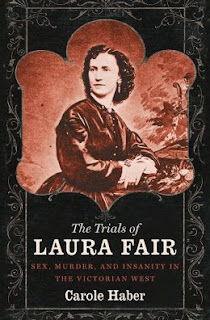
She applied the “Page 99 Test” to her new book, The Trials of Laura Fair: Sex, Murder, and Insanity in the Victorian West, and reported the following:
The Trials of Laura Fair explores Laura Fair’s shooting of her married lover AP Crittenden in 1871 and the subsequent courtroom hearings held to determine her fate. Upon Crittenden’s death, Laura immediately attained national notoriety. The press published stories of her infamous past, often with their own imaginary salacious details. The nation was outraged; except for leading suffrage advocates who adamantly supported her, most of the public and the press demanded her death. Her explanation that she was temporarily insane when she fired the pistol due to a painful and irregular menstrual cycle appeared to most to be ludicrous at best. Thus, while the defense hoped to make her trials about the medical condition of menstruating women, the prosecution attempted to prove that she was nothing more than a loose woman whose reputation alone proved she should be hanged.Learn more about The Trials of Laura Fair at the University of North Carolina Press website.
Page 99 situates the story in the first of the two trials. The defense has recalled to the witness stand Dr. John Trask. They hope he will convince the jury that serious “female problems” excused her murderous behavior. Trask has taken the stand following the extensive examination of their first medical expert, Dr. Benjamin Lyford. Unfortunately for the defense, Lyford did little but confuse the courtroom by his pretentious testimony and raised serious questions about whether he actually possessed any medical training or a degree. In addition, Lyford’s disdain for the court and his failure to return to the stand due to his own supposed medical problems hardly won over a skeptical press or public.
Thus, while Trask was able to explain Laura’s supposed symptoms in far more understandable terms, the state of the medical profession and the confusion over definitions of insanity negated much of the testimony. Although in the second trial, such issues would take center stage, as page 99 reveals, initially, the prosecution was able to dismiss such testimony and focus the hearing squarely on Laura’s “loose behavior” and ruined reputation.
So page 99 tells part of the story. Although the two trials eventually had radically different outcomes, the question of insanity and the impact of female physiology do play central parts in the drama. But the trials also became forums for discussing the leading issues of the day including free love, suffrage, the unwritten law, middle-class reputation, and the gendered nature of American courts. Moreover, as the final chapters of the book reveal, well after the final verdict, and even after her death, the story of Laura Fair was repeatedly told and reinterpreted. Over the course of a century, she became a colorful symbol on which to place ever-changing beliefs about the nature of ‘bold’ Victorian women who dared to claim their place in the American West.
Carole Haber is professor of history and dean of the School of Liberal Arts at Tulane University.
My Book, The Movie: The Trials of Laura Fair.
--Marshal Zeringue



